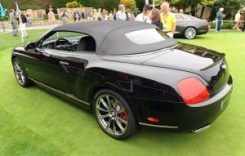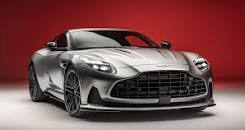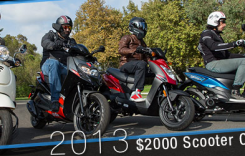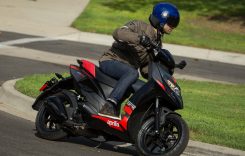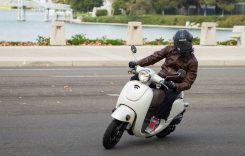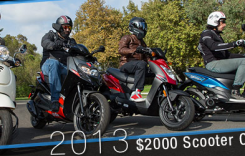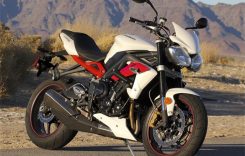Nobody goes into a European motorcycle shop expecting bargains. But Piaggio – which makes Aprilia, Vespa, Moto Guzzi and Piaggio products – has a global network of suppliers and factories and has been delivering some surprising deals of late. When I saw Piaggio had not one but two scooters under $2000, I had to ask for both.
Queue the “whaa-whaa” trumpet sound effect. When we went to pick up the scooters at Piaggio’s Costa Mesa, California Tech center, we discovered the Piaggio Typhoon 50 and Aprilia Motard SR50 are actually identical, done up in different paint and graphics (though Justin noted the Piaggio has grippier seat material). For some reason, the Typhoon is $100 cheaper than the Aprilia, but we all liked the sportier look of the Aprilia and would probably skip a few steak dinners to pay for it.

Both scooters use a tube-steel frame wrapped in stylish plastic bodywork. Underneath, there’s a new 49cc four-stroke, four-valve, air-cooled motor making a claimed 4.5 horsepower at 9500 rpm – a seriously sporty redline for a small scooter. It’s economical, too, with Piaggio claiming 144 mpg; that means serious range from the 1.8 gallon tank, even if in actual use your mileage will probably be far less. The wheelbase is 53.1 inches, and the 14-inch wheels are the biggest in the test. Seat height is a manageable 30.3 inches, but claimed dry weight is a hefty 242 pounds.

My expectations from a European product are that it will have great design, look good and show off some old-world craftsmanship. The Aprilia and Piaggio delivered, but the scooters also worked well, with everybody impressed by the excellent handling and cornering clearance.
“Thanks to the well-sorted suspension and large wheels,” wrote Justin, “the Aprilia and Piaggio were the shredders of the group when it was time to deal with a corner.” Waheed found they were “the most sporty and adept at putting a smile on your face around turns.”
I thought the difference between the Piaggio suspension and handling was as stark as the difference between the KYMCO’s motors and the 49cc motors on the other three bikes – this is a scooter that will be fun for riders experienced and confident enough to really fling their bikes into corners. In the parking-lot GP, I noted that a rider on the Motard or Typhoon would walk away from the KYMCO, as the bigger scooter’s motor can’t overcome its deficits in suspension and chassis feel.

Comfort and convenience is good for the money, too. The bike’s roomy dimensions made it appealing to a wide array of riders, with a natural reach to the bars and a reasonably comfy seat. There’s room for a helmet under the seat, and there’s additional storage in the leg shield. The bigger size means a passenger will be more comfortable, especially if they use the grabrails. A fuel gauge is a nice touch, although it lacks a resettable tripmeter (as do all the bikes in our test).
Power delivery is much better than I expected from a 49cc four-stroke. The Motard and Typhoon will get a patient rider up to 40 mph if there’s enough room. It’s enough to keep up with most urban traffic situations, though steep hills are a challenge. Waheed noted an almost two-stroke feel, with power coming on late in the game, and Justin noticed the sluggish acceleration off the line, the price for the taller gearing needed to milk the scooters’ revvy nature for maximum speed. Aside from the soft motor, the only other real complaint was the soft rear brake – a “Motard” scooter should be able to do a nice rear-wheel slide!

The Piaggio scooters were winners, providing fun, good quality and sportbike-like handling characteristics for under $2000. Although it was unsaid, I’m sure we’d all imagine the ultimate lightweight scooter would combine the Piaggio chassis and style with the KYMCO’s killer motor – and in fact, for another eight Benjamins, you can get the Typhoon 125, though it’s not quite the same chassis as the 50 – it’s heavier and has 12-inch wheels.
Waheed summed it up nicely: “These scooters will be great for those looking for a little more sport appeal with a little more practicality than the Honda and refinement and overall build quality compared to the KYMCO.”
